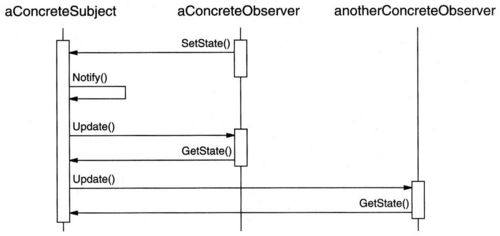Observer (padrão de desenho): Difference between revisions
From Wiki**3
No edit summary |
|||
| Line 127: | Line 127: | ||
} | } | ||
} | } | ||
===Dois contextos=== | |||
Os dois contextos de utilização correspondem a duas estações meteorológicas: em cada uma são utilizados observadores diferentes sobre os mesmos dados. | |||
<B>public</B> <B>class</B> WeatherStation { | |||
<B>public</B> <FONT COLOR="#800000">static</FONT> <FONT COLOR="#800000">void</FONT> <FONT COLOR="#000080">main</FONT>(<B><FONT COLOR="#0095ff">String</FONT></B>[] args) { | |||
WeatherData weatherData = <B>new</B> <FONT COLOR="#000080">WeatherData</FONT>(); | |||
CurrentConditionsDisplay currentDisplay = <B>new</B> <FONT COLOR="#000080">CurrentConditionsDisplay</FONT>(weatherData); | |||
StatisticsDisplay statisticsDisplay = <B>new</B> <FONT COLOR="#000080">StatisticsDisplay</FONT>(weatherData); | |||
ForecastDisplay forecastDisplay = <B>new</B> <FONT COLOR="#000080">ForecastDisplay</FONT>(weatherData); | |||
weatherData.<FONT COLOR="#000080">setMeasurements</FONT>(<FONT COLOR="#0000ff">80</FONT>, <FONT COLOR="#0000ff">65</FONT>, <FONT COLOR="#800080">30.4f</FONT>); | |||
weatherData.<FONT COLOR="#000080">setMeasurements</FONT>(<FONT COLOR="#0000ff">82</FONT>, <FONT COLOR="#0000ff">70</FONT>, <FONT COLOR="#800080">29.2f</FONT>); | |||
weatherData.<FONT COLOR="#000080">setMeasurements</FONT>(<FONT COLOR="#0000ff">78</FONT>, <FONT COLOR="#0000ff">90</FONT>, <FONT COLOR="#800080">29.2f</FONT>); | |||
} | |||
} | |||
<B>public</B> <B>class</B> WeatherStationHeatIndex { | |||
<B>public</B> <FONT COLOR="#800000">static</FONT> <FONT COLOR="#800000">void</FONT> <FONT COLOR="#000080">main</FONT>(<B><FONT COLOR="#0095ff">String</FONT></B>[] args) { | |||
WeatherData weatherData = <B>new</B> <FONT COLOR="#000080">WeatherData</FONT>(); | |||
CurrentConditionsDisplay currentDisplay = <B>new</B> <FONT COLOR="#000080">CurrentConditionsDisplay</FONT>(weatherData); | |||
StatisticsDisplay statisticsDisplay = <B>new</B> <FONT COLOR="#000080">StatisticsDisplay</FONT>(weatherData); | |||
ForecastDisplay forecastDisplay = <B>new</B> <FONT COLOR="#000080">ForecastDisplay</FONT>(weatherData); | |||
HeatIndexDisplay heatIndexDisplay = <B>new</B> <FONT COLOR="#000080">HeatIndexDisplay</FONT>(weatherData); | |||
weatherData.<FONT COLOR="#000080">setMeasurements</FONT>(<FONT COLOR="#0000ff">80</FONT>, <FONT COLOR="#0000ff">65</FONT>, <FONT COLOR="#800080">30.4f</FONT>); | |||
weatherData.<FONT COLOR="#000080">setMeasurements</FONT>(<FONT COLOR="#0000ff">82</FONT>, <FONT COLOR="#0000ff">70</FONT>, <FONT COLOR="#800080">29.2f</FONT>); | |||
weatherData.<FONT COLOR="#000080">setMeasurements</FONT>(<FONT COLOR="#0000ff">78</FONT>, <FONT COLOR="#0000ff">90</FONT>, <FONT COLOR="#800080">29.2f</FONT>); | |||
} | |||
} | |||
[[category:PO 2005/2006]] | [[category:PO 2005/2006]] | ||
Revision as of 18:15, 19 November 2005
Material correspondente à aula 28.
O padrão observer permite observar o estado de um objecto. Os observadores registam o seu interesse no estado junto do objecto; quando o estado do objecto muda, os observadores são notificados.
Estrutura
Diagrama de classes
O padrão observer tem a seguinte estrutura de classes:
Diagrama de sequência
As colaborações entre os intervenientes são as que figuram no seguinte diagrama de sequência:
Exemplo
Observadores e Observados
public interface Subject {
public void registerObserver(Observer o);
public void removeObserver(Observer o);
public void notifyObservers();
}
public interface Observer {
public void update(float temp, float humidity, float pressure);
}
Apresentação
Esta interface define o método básico para apresentação de dados.
public interface DisplayElement {
public void display();
}
As implementações da interface de apresentação, que implementam também a de observação, definem várias formas de exibição de dados.
public class CurrentConditionsDisplay implements Observer, DisplayElement {
private float temperature;
private float humidity;
private Subject weatherData;
public CurrentConditionsDisplay(Subject weatherData) {
this.weatherData = weatherData;
weatherData.registerObserver(this);
}
public void update(float temperature, float humidity, float pressure) {
this.temperature = temperature;
this.humidity = humidity;
display();
}
public void display() {
System.out.println("Current conditions: " + temperature
+ "F degrees and " + humidity + "% humidity");
}
}
public class ForecastDisplay implements Observer, DisplayElement {
private float currentPressure = 29.92f;
private float lastPressure;
private WeatherData weatherData;
public ForecastDisplay(WeatherData weatherData) {
this.weatherData = weatherData;
weatherData.registerObserver(this);
}
public void update(float temp, float humidity, float pressure) {
lastPressure = currentPressure;
currentPressure = pressure;
display();
}
public void display() {
System.out.print("Forecast: ");
if (currentPressure > lastPressure) {
System.out.println("Improving weather on the way!");
} else if (currentPressure == lastPressure) {
System.out.println("More of the same");
} else if (currentPressure < lastPressure) {
System.out.println("Watch out for cooler, rainy weather");
}
}
}
Representação de dados
Os dados de meteorologia correspondem ao objecto observado.
public class WeatherData implements Subject {
private ArrayList observers;
private float temperature;
private float humidity;
private float pressure;
public WeatherData() { observers = new ArrayList(); }
public void registerObserver(Observer o) { observers.add(o); }
public void removeObserver(Observer o) {
int i = observers.indexOf(o);
if (i >= 0) { observers.remove(i); }
}
public void notifyObservers() {
for (int i = 0; i < observers.size(); i++) {
Observer observer = (Observer)observers.get(i);
observer.update(temperature, humidity, pressure);
}
}
public void measurementsChanged() { notifyObservers(); }
public void setMeasurements(float temperature, float humidity, float pressure) {
this.temperature = temperature;
this.humidity = humidity;
this.pressure = pressure;
measurementsChanged();
}
}
Dois contextos
Os dois contextos de utilização correspondem a duas estações meteorológicas: em cada uma são utilizados observadores diferentes sobre os mesmos dados.
public class WeatherStation {
public static void main(String[] args) {
WeatherData weatherData = new WeatherData();
CurrentConditionsDisplay currentDisplay = new CurrentConditionsDisplay(weatherData);
StatisticsDisplay statisticsDisplay = new StatisticsDisplay(weatherData);
ForecastDisplay forecastDisplay = new ForecastDisplay(weatherData);
weatherData.setMeasurements(80, 65, 30.4f);
weatherData.setMeasurements(82, 70, 29.2f);
weatherData.setMeasurements(78, 90, 29.2f);
}
}
public class WeatherStationHeatIndex {
public static void main(String[] args) {
WeatherData weatherData = new WeatherData();
CurrentConditionsDisplay currentDisplay = new CurrentConditionsDisplay(weatherData);
StatisticsDisplay statisticsDisplay = new StatisticsDisplay(weatherData);
ForecastDisplay forecastDisplay = new ForecastDisplay(weatherData);
HeatIndexDisplay heatIndexDisplay = new HeatIndexDisplay(weatherData);
weatherData.setMeasurements(80, 65, 30.4f);
weatherData.setMeasurements(82, 70, 29.2f);
weatherData.setMeasurements(78, 90, 29.2f);
}
}

